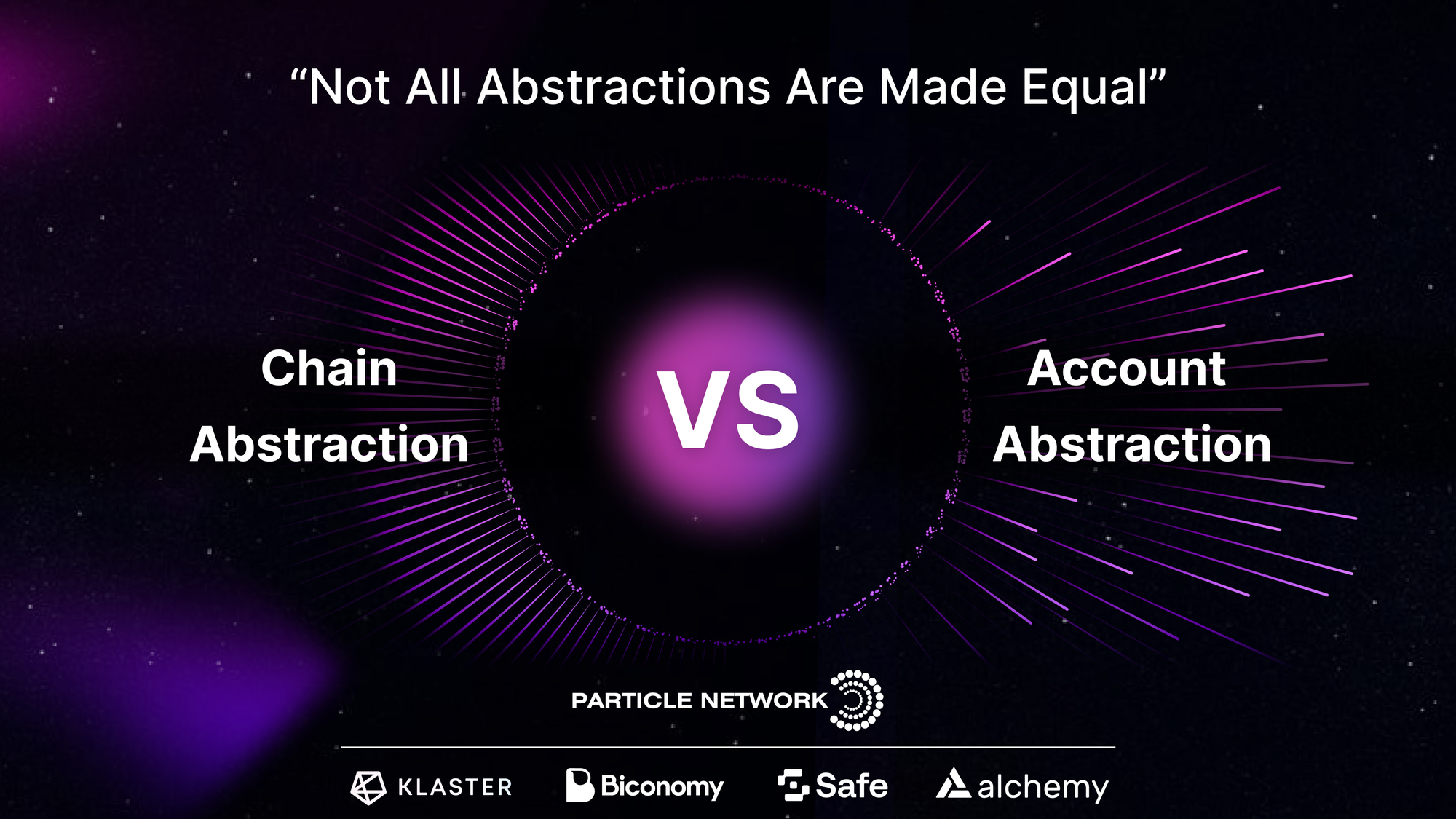Chain Abstraction vs Account Abstraction (ft. Safe, Biconomy, Alchemy & Klaster): "Not All Abstractions Are Made Equal"

Table of Contents:
We hear the same thing all the time:
“BUT PARTICLE, chain abstraction and account abstraction are very similar ideas, but AA hasn’t yet managed to drive high adoption! How can chain abstraction take off, then?”
Indeed, ChA is often mistaken for a repackaged version of AA. This originates from surface-level similarities and the fact that chain abstraction—like account abstraction—aims to solve Web3’s user experience problems (although it goes far beyond!)
This article will explain the critical differences and dynamics at play between ChA and AA. We will also showcase some of our conversations with leading players in both fields (Safe and Biconomy for AA and Klaster for ChA) to showcase how both innovations can work together to accelerate Web3’s growth in the Abstraction Age.
History in broad strokes
Let’s start from the beginning.
Account abstraction emerged as a proactive solution to make Web3 friendlier. The idea behind it is that by making accounts programmable (that is, smart contracts), users could access many benefits—such as social recovery, spending rules, gas sponsorships, automated transactions, and pre-approved signatures.
AA drove significant backing, and its execution is currently “outsourced” to the ERC-4337 standard (full history here) before its eventual “enshrining” into Ethereum. However, its current lack of adoption has driven skepticism across the industry, where a new narrative has taken over—inevitably stirring comparisons.
Two common misconceptions about Chain Abstraction:
— Pengyu (@0xpengyu) October 2, 2024
1. ChA is a repackaging of Account Abstraction:
"If Account Abstraction hasn't been that successful from a business perspective (no killer apps, no leading assets created from the Account Abstraction narrative, primary market…
Particle’s CEO and Co-Founder weighs in on this debate
The emergence of chain abstraction
Just as AA can be understood as a technology, chain abstraction can be better characterized as an experience.
Unlike AA (a proactive solution), ChA was born as an organic response to a pressing need in Web3. It aims to address the fragmentation of users and liquidity across multiple chains—a challenge that only grows as the L1 and L2 ecosystem expands—by eliminating the manual processes required to interact with multiple chains.

Furthermore, there are many ways to achieve chain abstraction, with an industry-wide implementation involving all of them:

Similarly, implementing chain abstraction does not involve just one technology. Instead, it’s constituted by the utilization of several different foundational technologies—one of them being AA.

ChA enables a dynamic, synchronized multi-chain system where assets and dApps are instantly accessible across different blockchains. As such, it represents not just an incremental UX upgrade, but a paradigm shift that could pave the way for mass adoption and optimized liquidity across Web3.
Alchemy, a platform deploying tools for Web3 developers also driving AA's growth, also sees AA as a foundation for ChA:
"As more and more rollups and chains become available, ChA has the potential to make it even easier for builders and users alike to manage assets and wallets across different chains. Seamless ChA is only possible with AA and smart accounts, as accounts need the ability to be programmatically connected to the services that orchestrate chain abstraction," they say.
Let’s now take a closer look into the role of AA within ChA, as well as their adoption roadmaps.
So, why hasn’t AA’s adoption exploded?
Simply put, Web3’s current biggest problem is not that the experience of using accounts and dApps is too complex. Instead, fragmentation prevents existing users from accessing the ecosystem at large, also making it less attractive for newcomers and preventing the emergence of better dApps.
As an example, for a user to begin using a dApp, they need to:
- Hold at least one cryptocurrency—a barrier keeping most users out.
- Hold these tokens in the chain the dApp is on or bridge them to it. This, besides causing significant friction, may incur expenses.
- Hold or acquire the network’s native gas token.
Users meeting all these conditions likely have the incentive to use the dApp, and will do so almost regardless of friction. However, for everyone else, fragmentation makes Web3 as a whole unattractive.
The larger picture presents a unique scenario: Users can seriously benefit from more flexible accounts, but these are currently more valuable as building blocks to solve the fragmentation of users and liquidity. Once this problem is overcome, Web3’s infrastructure will be increasingly synergetic, becoming solid enough to facilitate the creation of better dApps.

Relating Chain Abstraction to Account Abstraction: how does ChA leverage AA?
Since AA’s adoption by dApps hasn’t yet made a big impact, it’s not completely unlikely that ChA solutions will be the first to spread this technology to the masses.
Within the layered model mentioned above, there are two types of ChA solutions that greatly benefit from AA:
Account-level solutions
Account-level solutions, like Universal Accounts, rely on account abstraction to enable the experience of a unified address and balance across every chain. Within Universal Accounts, custom Smart Account deployments across multiple chains are coordinated by an underlying chain (the Particle Network L1), giving users a single interaction point across all of Web3.
The user then can leverage their Universal Account to interact with dApps on any ecosystem, focusing their experience on products, not ecosystems.

Application-level (or “orchestration”) solutions
These services hugely benefit from the programmability of AA and the borderless paradigm created by other ChA solutions, providing an additional layer of functionality for developers to span the whole of Web3 with their dApps. The ultimate goal of orchestration services is the creation of chain-agnostic dApps.
About this, Klaster, a protocol allowing developers to build chain-abstracted flows and dApps, comments:
“The infrastructure being built right now is the first step in onboarding a wave of developers that joins the space for the sake of building cool new use cases without having to think much about the underlying chains they're interacting with or where liquidity sits. As this happens and appchains/L2s become a reality, both AA and orchestration can expect to accelerate in adoption.
With many L2s and universes (Superchain, AggLayer, etc.), as well as ecosystems (EVM, non-EVM), orchestration layers will become even more important, sitting closest to users/devs and capturing value.”
Klaster hints at the importance of all chain abstraction solutions in unifying an expanding ecosystem—a driving force of fragmentation. They also foresee the empowering of developers via orchestration, driving AA to flourish. With this as a starting point, we’ll next focus on the role of ChA in improving developers’ experience, leveling the playing field across Web3, and its repercussions for AA.
AA in the Abstraction Age
As the Abstraction Age unfolds, developers will find more powerful tools to prioritize innovative use cases and intuitive user experiences. We talked to two of the AA ecosystem’s leading teams about the evolution of the AA paradigm, as well as its relation to ChA.
Ahmed Al-Balaghi, Co-Founder of Biconomy, highlights how AA is evolving on its own:
“Modules, infra, and contracts are all helping spearhead chain abstraction. Account abstraction will be further empowered by EIP-7702 as well,” he says, pointing to how this development could shift the account abstraction roadmap entirely.
For context, EIP-7702 is a new proposal that aims to make the future of AA even more promising. This proposal introduces a new transaction type for EVM networks, allowing externally owned accounts (EOAs) to adopt smart contract code during transactions. By enabling EOAs to access features previously exclusive to Smart Accounts—such as gas sponsorships and batched transactions—EIP-7702 offers a streamlined path for dApps to leverage AA without requiring users to migrate away from EOAs.
Safe, the largest Smart Account ecosystem in Web3, also comments on the importance of EIP-7702:
“EIP-7702 is an exciting development. Previously, only Smart Accounts could access features like sponsored and batched transactions. Now, with EIP-7702, EOAs can use these features as well. This change will provide valuable data on how quickly users adopt these capabilities and indicate their interest in converting EOAs to Smart Accounts.” says Safe’s founder, Lukas Schor.
Similarly, both projects commented on ChA, its relationship with AA, and how they can continue evolving simultaneously.
“Chain abstraction is being explored from multiple perspectives, but we believe that user trust is the foundation for delivering chain-agnostic solutions. Ideally, ChA should begin at the account level. Wallet providers and Smart Account platforms, having already earned user trust, are in the best position to offer solutions for a chain-abstracted future,” explains Safe’s Valentin Seehausen.
Furthermore, recognizing the importance of ChA in driving AA’s adoption, Biconomy has envisioned a roadmap to support it at scale:
"Chain abstraction definitely plays a role in this. But we also need a friend.tech moment for Smart Accounts. Infinex is closest to that”—adds Ahmed, referring to a viral application leading to rapid, widespread adoption.
AA’s broader role in the Abstraction Age is, therefore, twofold: empowering ChA as a foundational component while facilitating friendlier user experiences, benefiting from the expansive environment that ChA will create.
Biconomy’s Co-Founder also covered AA’s difficulties in driving adoption, which can be tackled by giving users the incentive of benefiting from account-level ChA solutions:
“We see a few reasons (for slow adoption). It’s a bit hard to integrate AA for devs. It’s also not widely supported by all dApps (creating compatibility issues), and, third, most dApps assume and build with EOAs only.”
In conclusion, there’s a consensus that chain abstraction and account abstraction need to evolve in tandem, with chain abstraction as an accelerant. Only then can AA become a standard for users, transforming how developers design and deploy blockchain applications. With the emergence of ChA, Alchemy shares a positive outlook:
In the future, we see AA enabling more composable, modular dApps, where smart accounts serve as the core programmable layer for seamlessly interacting with various services. Modular smart account standards like ERC-6900 and its module ecosystem will help simplify and accelerate dApp development.
Final thoughts
Since the differences, similarities, and synergies between ChA and AA are clear by now, we will wrap up this article on a philosophical note.
In the grand scheme of things, blockchains’ greater purpose is to be coordination mechanisms, creating financial incentives to push decentralization forward. As such, despite the lack of dApps adopted by the masses, it’s also important to recognize the degree to which this coordination is occurring—with the ecosystem increasingly delivering complex, open-source public goods to be used towards its own expansion.
The next few months will see Web3 enter the Abstraction Age, alongside a widespread adoption of AA.
Excited, anon?
Particle Network's Chain Abstraction solutions are 100% free for developers and teams. By integrating them, you can set your project in a path to leveraging chain abstraction.
About Particle Network

Particle Network powers chain abstraction, addressing Web3's fragmentation of users and liquidity. This is enabled by Particle's Universal Accounts, which give users a unified account and balance across all chains.
Share this article
About the author(s)


